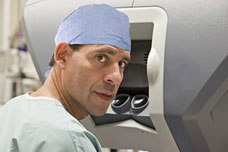Blazing a trail in robotic surgery

Fascinated by medicine as a boy, UC Irvine’s Dr. Robert Bristow today is pioneering advanced robotic surgery techniques for gynecological cancers
For the last several years, UC Irvine gynecologic oncologist Robert Bristow, M.D., has been named one of the Best Doctors in America® for gynecologic cancers. But for much of his life, the medical mastermind in the family was his father.
Growing up as the son of a prominent internist in the San Francisco Bay Area, the young Bristow spent summers during high school working in his father’s office.
Dr. Lonnie R. Bristow was one of the nation’s first physicians to explore occupational health, carving out a new area of medicine through his work on the health effects of asbestos exposure. As the first African American president of the American Medical Association, he launched initiatives to improve public health, encourage HIV/AIDS education and require medical schools to offer ethics classes.
“I witnessed first hand how satisfying it was for him to practice medicine,” recalls Bristow, director of Gynecologic Oncology Services for UC Irvine Healthcare. “People would seek him out in the grocery store to thank him for what he did for them.” Originally, he thought he would become an internist, too. But after taking his first gross anatomy class, he decided he would pursue surgery, eventually becoming one of the foremost robotic surgery specialists for gynecologic cancers in the country.
Robotic surgical systems represent the latest development in minimally invasive surgical techniques, giving surgeons far more precise tools to operate through the same keyhole-sized incisions used in conventional laparoscopy. Standard laparoscopy requires surgeons to completely re-direct their hand motions. To move the miniature camera scope up, for example, they have to move their hand downward.
“With robotic surgery, everything is synchronized with your vision and hand motions, so it’s almost like doing surgery in a fishbowl,” says Bristow, who began experimenting with the equipment in 2007 and embraced it fully in 2008.
Robotic surgical systems are enabling physicians to perform extensive surgeries through the tiniest of incisions. As surgeons become more comfortable with the technology, they’re expanding the types of robot-assisted procedures they perform. Bristow, for example, is using robotic technology for total hysterectomies—something surgeons would never have considered five or 10 years ago.
“The most gratifying aspect of robotic surgery is seeing patients afterward,” he says. “They’ve just had a hysterectomy and a week or two after surgery, they’re walking around like nothing happened. They’re back to work much faster. There’s less pain and suffering than with traditional surgery. It’s just better all the way around.”
However, Bristow is quick to point out that not every patient is a candidate for robot-assisted surgery. Those who have had extensive surgery previously, who are significantly overweight or who have certain conditions may require traditional open surgery.
In perfecting his skill at robotic surgery, Bristow has become a trailblazer too, pioneering advanced techniques for the management of a variety of gynecological cancers. Recognized internationally as a leading expert in ovarian, fallopian tube, primary peritoneal and endometrial cancers, he is the author of several books on ovarian cancer and he has published extensively in the field of ovarian cancer research. Recently, he was appointed to the UC Irvine School of Medicine’s Philip J. DiSaia Chair in Gynecologic Oncology, becoming the first to hold the endowed chair named for the university's highly respected former chief of the Division of Gynecologic Oncology.
"While working as a surgical fellow, I was instilled with a philosophy to continue to grow as a surgeon and clinician, to not be satisfied with a stagnant skill set,” he says. “The robotics platform was a natural outgrowth of that. It was a means of expanding my personal surgical repertoire in minimally invasive surgery.”
As for his father, the elder Bristow is fascinated and impressed by how far technology has advanced during his lifetime. “But he has no plans to perform robot-assisted surgery,” adds Bristow.
